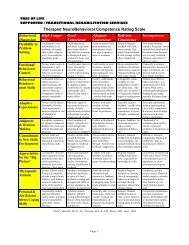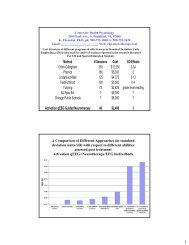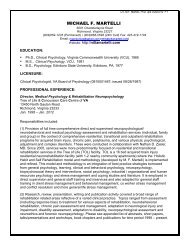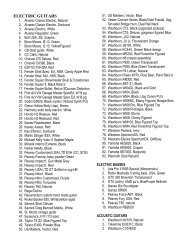Slull reacquisition after acquired brain injury - villa martelli disability ...
Slull reacquisition after acquired brain injury - villa martelli disability ...
Slull reacquisition after acquired brain injury - villa martelli disability ...
You also want an ePaper? Increase the reach of your titles
YUMPU automatically turns print PDFs into web optimized ePapers that Google loves.
124 M.F: Martelli et a[. /Skill <strong>reacquisition</strong> <strong>after</strong> <strong>acquired</strong> <strong>brain</strong> <strong>injury</strong><br />
member how to walk, so the sequences involved in<br />
walking are chained together in a task analysis that<br />
makes it automatic so that performance requires min-<br />
imal thought and energy. The same conversion oc-<br />
curs when such habits as attentional focusing, memory,<br />
and multi-tasking are <strong>acquired</strong> and automated through<br />
chaining of the component steps. Through learning,<br />
internally incorporating the tasks that are involved in<br />
getting dressed, or remembering what to take with us<br />
when we leave the house, etc. are <strong>acquired</strong> as habits<br />
through natural task analysis that sequences behaviors<br />
as if we were learning automatic task inventories. The<br />
same is true for self control habits ranging from ini-<br />
tiation and awareness to inhibition, which involve the<br />
very complex chaining of multiple tasks to produce the<br />
highest level executive shlls habits.<br />
Although HHR shares many features with other<br />
holistic neurorehabilitation models, it also provides a<br />
distinctive and unique approach. HHR is a parsimo-<br />
nious model that is relatively simple to understand and<br />
apply. It offers an uncomplicated and intuitively ap-<br />
pealing model and methodology for devising and indi-<br />
vidualizing specific retraining protocols. Protocol tem-<br />
plates have been developed for a broad range of relevant<br />
skills areas. Most importantly, HHR recognizes the<br />
powerful importance of psychotherapy, or neuropsy-<br />
chotherapy, synchronizing it with potent and compati-<br />
ble learning methods. It integrates psychotherapy as an<br />
inseparable part of the rehabilitation process. HHR em-<br />
powers therapists and family members as agents armed<br />
with highly potent neurorehabilitation-specific learn-<br />
ing and psychotherapeutic strategies. Finally, and ul-<br />
timately, HHR aims to expand "neuropsychotherapeu-<br />
tic" rehabilitation beyond enhancing emotional adjust-<br />
ment and functional compensation to include promo-<br />
tion of neuroplastic based rehabilitation of cognitive,<br />
behavioral and physical capabilities.<br />
References<br />
[l] S. Akhtar, C.J. Moulin and P.C. Bowie, Are people with mild<br />
cognitive impairment aware of the benefits of errorless learn-<br />
ing? Neuropsychol Rehabilitation 16 (2006), 329-346.<br />
121 N.D. Anderson and F.I. Craik, The mnemonic mechanisms of<br />
errorless learning, Neuropsychologia 44 (2006). 2806-2813.<br />
131 M.C. Bender, M.F. Martelli and N.D. Zasler, A Graduated Ex-<br />
posure Protocol for Post Traumatic Driving Anxiety, Present-<br />
ed at the Williamsburg Traumatic Brain Injury Conference,<br />
27th Annual Meeting, Williamsburg, 2003.<br />
[4] Y. Ben-Yisbay, Postacute Neuropsychological Rehabilitation,<br />
in: lntenlational Handbook of Neuropsychological Reha-<br />
bilitation, Christenson and Uzzell, eds, Kluwer Academ-<br />
iclPlenum, New York, 2000.<br />
A.E. Bergin and S.L. Garfield, eds, Handbook of Psychotherapy<br />
and Behavior Change: An Empirical Analysis, 4th ed.,<br />
John Wiley and Sons, New York. 1994.<br />
L. Clare, B.A. Wilson, G. Carter, I. Roth and J.R. Hodges,<br />
Relearning face-name associations in early Alzheimer's disease,<br />
Nerrropsychology 16 (2002), 538-547. Y. Ben-Yishay,<br />
Postacute Neuropsychological Rehabilitation, in: Internntiona1<br />
Handbook of Nerrrop.sychologica1 Rehabilitation, Chnstenson<br />
and Uzzell, eds. Kluwer Academic/Plenum. New York.<br />
2000.<br />
S.L. Dubovsky. Mind-Body Deceptions: The Psychosomatics<br />
ofEveryday Life, Norton, New York, 1997.<br />
J.M. Ducharme, "Errorless" rehabilitation strategies of proactive<br />
intervention for individuals with <strong>brain</strong> <strong>injury</strong> and their<br />
children, Journal of Head Trauma Rehabilitation 18 (2003),<br />
88-105.<br />
J.D. Frank, Therapeutic components of psychotherapy: A 25year<br />
progress report of research, Journal of Nervous and Mental<br />
Diseases 159 (1974). 325-342.<br />
J.D. Frank. Therapeutic components shared by all psychotherapies,<br />
in: Psychotherapy Research and Behavior Change, J.H.<br />
Harvey and M.M. Peeks, eds, American Psychological Association,<br />
Washington, DC, 1982, pp. 9-37.<br />
J.D. Frank, The placebo is psychotherapy, The Behavioral and<br />
Brain Sciences 6 (1983), 291-292.<br />
J.D. Frank and J.B. Frank. Persuasion and Healing: A Comparative<br />
Study of Psychotherapy, The Johns Hopkins University<br />
Press. Baltimore. MD. 1991.<br />
J.D. Frank, Persuasion and Healing: A Comparative Study of<br />
Psychotherapy. Johns Hopkins University Press, Baltimore,<br />
MD, 1993.<br />
E.L. Glisky and D.L. Schacter, Extending the limits of complex<br />
learning in organic amnesia: computer training in a vocational<br />
domain, Neuropsychologia 27 (1989), 107-120.<br />
K. Goldstein, The Organism: A Holistic Approach to Biology<br />
Derived from Pathological Data in Man, American Book Co:<br />
1939: Zone Books, New York. 1995.<br />
R. Greenwood, The future of rehabilitation, Lies in retraining,<br />
replacement, and regrowth, British Medical Journal 323<br />
(2001), 1082-1083.<br />
C. Haslam, D. Gilroy, S. Black and T. Beesley, How successful<br />
is errorless learning in supporting memory for high and lowlevel<br />
knowledge in dementia? Neuropsychol Rehabil5 (2006),<br />
505-536.<br />
C.A. Hopewell, The Neuropsychological Assessment of Personality<br />
and Emotional Changes <strong>after</strong> Traumatic Brain Injury,<br />
IMH-Network, Limited, Sparks, NV, 2001.<br />
M.A. Hubble, B.L. Duncan and S.D. Miller, eds, The Heart<br />
and Soul of Change: What Works in Therapy, American Psychological<br />
Association, Washington, DC, 1999.<br />
W. James, The Principles of Psychology. Vol. 2, Henry Holt<br />
and Co, New York, 1890.<br />
J. Jerome, E.P. Frantino and P. Sturmey. The effects of errorless<br />
learning and backward chaining on the acquisition of Internet<br />
skills in adults with developmental disabilities, JAppl Behav<br />
Anal 40 (2007), 185-189.<br />
D.H. Jonassen. M. Tessmer and W.H. Hannum, Task Analysis:<br />
Methods for Instructional Design, Lawrence Erlbaum<br />
Associates, Mahwah, NJ, 1999.<br />
R.S. Kern, R.P. Liberman, A. Kopelowicz, J. Mintz and M.F.<br />
Green, Applications of Errorless Learning for Improving Work<br />
Performance in Persons With Schizophrenia, An~erican Journal<br />
of Psychiatry 159 (2002). 921-1926.








